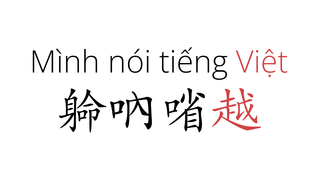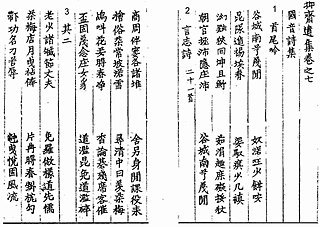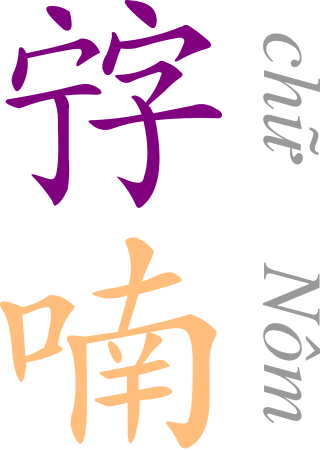Concept
For non-official purposes prior to the 20th century, Vietnamese had a writing system known as Hán-Nôm. Sino-Vietnamese numbers were written in chữ Hán and native vocabulary was written in chữ Nôm. Hence, there are two concurrent system in Vietnamese nowadays in the romanized script, one for native Vietnamese and one for Sino-Vietnamese.
In the modern Vietnamese writing system, numbers are written as Arabic numerals or in the romanized script chữ Quốc ngữ (một, hai, ba), which had a chữ Nôm character. Less common for numbers under one million are the numbers of Sino-Vietnamese origin (nhất [1], nhị [2], tam [3]), using chữ Hán (Chinese characters). Chữ Hán and chữ Nôm has all but become obsolete in the Vietnamese language, with the Latin-style of reading, writing, and pronouncing native Vietnamese and Sino-Vietnamese being wide spread instead, when France occupied Vietnam. Chữ Hán can still be seen in traditional temples or traditional literature or in cultural artefacts. The Hán-Nôm Institute resides in Hanoi, Vietnam.
Chinese numerals are words and characters used to denote numbers in written Chinese.
Myriad is technically the number 10,000 ; in that sense, the term is used in English almost exclusively for literal translations from Greek, Latin or Sinospheric languages, or when talking about ancient Greek numerals.

Vietnamese is an Austroasiatic language spoken primarily in Vietnam where it is the national and official language. Vietnamese is spoken natively by around 85 million people, several times as many as the rest of the Austroasiatic family combined. It is the native language of the Vietnamese (Kinh) people, as well as a second or first language for other ethnic groups in Vietnam.

In various East Asian languages such as Chinese, Japanese, Korean, and Vietnamese, the phrase "Wànsuì", "Banzai", "Manse", and "Vạn tuế", respectively, meaning "myriad years" is used to wish long life, and is typically translated as "Long live" in English. The phrase originated in ancient China as an expression used to wish long life to the emperor. Due to the historical political and cultural influence of Chinese culture on the East Asian cultural sphere, in the area, and in particular of the Classical Chinese language, cognates with similar meanings and usage patterns have appeared in many East Asian languages and Vietnamese. In some countries, this phrase is mundanely used when expressing feeling of triumph, typically shouted by crowds.
Articles related to Vietnam and Vietnamese culture include:

Spoken and written Vietnamese today uses the Latin script-based Vietnamese alphabet to represent native Vietnamese words, Vietnamese words which are of Chinese origin, and other foreign loanwords. Historically, Vietnamese literature was written by scholars using a combination of Chinese characters (Hán) and original Vietnamese characters (Nôm). From 111 BC up to the 20th century, Vietnamese literature was written in Văn ngôn using chữ Hán, and then also Nôm from the 13th century to 20th century.
Sino-Vietnamese vocabulary is a layer of about 3,000 monosyllabic morphemes of the Vietnamese language borrowed from Literary Chinese with consistent pronunciations based on Middle Chinese. Compounds using these morphemes are used extensively in cultural and technical vocabulary. Together with Sino-Korean and Sino-Japanese vocabularies, Sino-Vietnamese has been used in the reconstruction of the sound categories of Middle Chinese. Samuel Martin grouped the three together as "Sino-xenic". There is also an Old Sino-Vietnamese layer consisting of a few hundred words borrowed individually from Chinese in earlier periods. These words are treated by speakers as native words. More recent loans from southern varieties of Chinese, usually names of foodstuffs such as lạp xưởng 'Chinese sausage', are not treated as Sino-Vietnamese but more direct borrowings.

Dương Triệu Vũ is the stage name of Tuấn Linh, a singer on the popular Vietnamese diaspora music show Paris By Night.

The Anarchy of the 12 Warlords, also the Period of the 12 Warlords, was a period of chaos and civil war in the history of Vietnam, from 965 to 968 caused by the succession of the Ngô dynasty after the death of King Ngô Quyền. This period is also sometimes simply called the Twelve Warlords. Four of the warlords are verified to have traced their direct lineage from what is now China today. This period ended in 968 with the unification war of Vietnam by Đinh Bộ Lĩnh, who later established the Đinh dynasty.
Vietnamese is an analytic language, meaning it conveys grammatical information primarily through combinations of words as opposed to suffixes. The basic word order is subject-verb-object (SVO), but utterances may be restructured so as to be topic-prominent. Vietnamese also has verb serialization. In Vietnamese the head of the phrase usually precedes its complements, nouns are classified according to series of lexical parameters, and pronouns may be absent from utterances. Question words in the language do not exhibit wh-movement.

Edict on the Transfer of the Capital (chữ Hán: 遷都詔, chữ Nôm: 詔移都, Vietnamese: Thiên đô chiếu, Chiếu dời đô) is an edict written at the behest of emperor Lý Thái Tổ and issued in the fall of 1010 to transfer the capital of Đại Cồ Việt from Hoa Lư to Đại La.
Vietnamese poetry originated in the form of folk poetry and proverbs. Vietnamese poetic structures include Lục bát, Song thất lục bát, and various styles shared with Classical Chinese poetry forms, such as are found in Tang poetry; examples include verse forms with "seven syllables each line for eight lines," "seven syllables each line for four lines", and "five syllables each line for eight lines." More recently there have been new poetry and free poetry.

The Mười hai Bà mụ, or Thập nhị Bà thư, "Twelve Midwives" also called Mẹ Sanh are deities from Vietnamese mythology and folk religion. They are twelve fairies who teach babies various prosperous traits and skills such as sucking and smiling. In some parts of Vietnam when a baby is one month old a special ritual is performed for the "Twelve Midwives."

The Quốc âm thi tập is a collection of Vietnamese poetry written in the vernacular chữ Nôm script attributed to Nguyễn Trãi. The collection of 254 poems was traditionally written after Nguyễn Trãi's retirement from court life. It was complied around the reign of emperor Lê Thánh Tông (1460–1497).

Chữ Nôm is a logographic writing system formerly used to write the Vietnamese language. It uses Chinese characters to represent Sino-Vietnamese vocabulary and some native Vietnamese words, with other words represented by new characters created using a variety of methods, including phono-semantic compounds. This composite script was therefore highly complex and was accessible to less than five percent of the Vietnamese population who had mastered written Chinese.

Chữ Hán is the term for Chinese characters in Vietnamese. Chữ Hán are used to write Literary Chinese and Sino-Vietnamese vocabulary in the Vietnamese language. They were officially used in Vietnam after the Red River Delta region was incorporated into the Han dynasty and continued to be used until the early 20th century where usage of Literary Chinese was abolished alongside the Confucian court examinations causing chữ Hán to fall into obscurity.

The seals of the Nguyễn dynasty can refer to a collection of seals specifically made for the emperors of the Nguyễn dynasty, who reigned over Vietnam between the years 1802 and 1945, or to seals produced during this period in Vietnamese history in general.

The abdication of Bảo Đại took place on 25 August 1945 and marked the end of the 143-year reign of the Nguyễn dynasty over Vietnam ending the Vietnamese monarchy. Emperor Bảo Đại abdicated in response to the August Revolution. A ceremony was held handing power over to the newly established Democratic Republic of Vietnam, which was established during the end of World War II in Asia as Vietnam had been occupied by French and later Japanese imperialists.

Võ Nguyễn Hoài Linh, better known by his stage name Hoài Linh, is a Vietnamese-American comedian and actor. A frequent collaborator of Thúy Nga center, he is known for his comedy performances alongside other artists such as Vân Sơn and Chí Tài.

Tam thiên tự is a Vietnamese text that was used in the past to teach young children Chinese characters and chữ Nôm. It was written around the 19th century. The original title of the text was originally Tự học toản yếu The book was believed to be complied by Ngô Thì Nhậm ; courtesy name, Hy Doãn.













